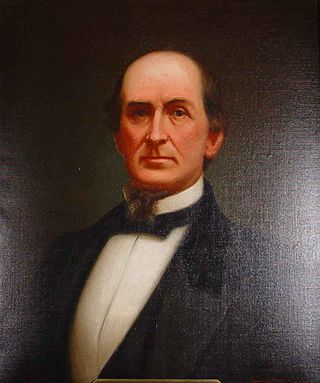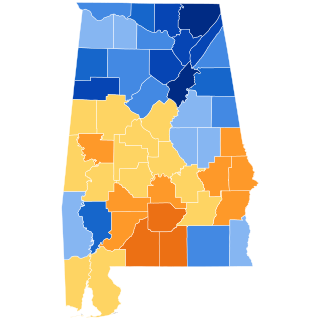
The 1852 United States presidential election was the 17th quadrennial presidential election, held on Tuesday, November 2, 1852. Democrat Franklin Pierce defeated Whig nominee General Winfield Scott. A third party candidate from the Free Soil party, John P. Hale, also ran and came in third place, but got no electoral votes.

The Solid South or the Southern bloc was the electoral voting bloc of the states of the Southern United States for issues that were regarded as particularly important to the interests of Democrats in those states. The Southern bloc existed between the end of the Reconstruction era in 1877 and the passage of the Civil Rights Act of 1964. During this period, the Democratic Party overwhelmingly controlled southern state legislatures, and most local, state and federal officeholders in the South were Democrats. During the late 1800s and early 1900s, Southern Democrats disenfranchised blacks in all Southern states, along with a few non-Southern states doing the same as well. This resulted essentially in a one-party system, in which a candidate's victory in Democratic primary elections was tantamount to election to the office itself. White primaries were another means that the Democrats used to consolidate their political power, excluding blacks from voting in primaries.

Robert Miller Patton was an American politician who served as the 20th governor of the Alabama from 1865 to 1868.

James Madison Wells was elected Lieutenant Governor and became the 20th Governor of Louisiana during Reconstruction.

The 1847 New York state election was held on November 2, 1847, to elect the lieutenant governor, the secretary state, the state comptroller, the attorney general, the state treasurer, the state engineer, three Canal Commissioners and three Inspectors of State Prisons, as well as all members of the New York State Assembly and the New York State Senate.

The 1852–53 United States Senate elections were held on various dates in various states, coinciding with the 1852 presidential election. As these U.S. Senate elections were prior to the ratification of the Seventeenth Amendment in 1913, senators were chosen by state legislatures. Senators were elected over a wide range of time throughout 1852 and 1853, and a seat may have been filled months late or remained vacant due to legislative deadlock. In these elections, terms were up for the senators in Class 2.

The 1839 Massachusetts gubernatorial election was a tightly contested race won by Marcus Morton. Under Massachusetts law at the time, a majority of the votes cast was required to win, and Morton received exactly half the votes cast. Despite the presence of some irregularities, incumbent Whig Governor Edward Everett refused to contest the results once a legislative committee dominated by his party accepted a report giving Morton 51,034 votes out of 102,066 cast.

The 1836 United States presidential election in Alabama took place between November 3 and December 7, 1836, as part of the 1836 presidential election. Voters chose seven representatives, or electors, to the Electoral College, who voted for President and Vice President.

The 1840 United States presidential election in Alabama took place between October 30 and December 2, 1840, as part of the 1840 United States presidential election. Voters chose seven representatives, or electors to the Electoral College, who voted for President and Vice President.

The 1844 United States presidential election in Alabama took place between November 1 and December 4, 1844, as part of the 1844 United States presidential election. Voters chose nine representatives, or electors to the Electoral College, who voted for President and Vice President.

The 1848 United States presidential election in Alabama took place on November 7, 1848, as part of the 1848 United States presidential election. Voters chose nine representatives, or electors to the Electoral College, who voted for President and Vice President.
The 1856 American National Convention was held in National Hall in Philadelphia, Pennsylvania, on February 22 to 25, 1856. The American Party, formerly the Native American Party, was the vehicle of the Know Nothing movement. The convention resulted in the nomination of former President Millard Fillmore of New York for president and former Ambassador Andrew Jackson Donelson of Tennessee for vice president.

The 1852 United States presidential election in Alabama took place on November 2, 1852, as part of the 1852 United States presidential election. Voters chose nine representatives, or electors to the Electoral College, who voted for president and vice president.

The 1835 Alabama gubernatorial election was an election held on August 3, 1835, to elect the governor of Alabama. Democratic candidate Clement Comer Clay beat Whig candidate Enoch Parsons with 65.44% of the vote.

The 1839 Alabama gubernatorial election was an election held on August 3, 1839, to elect the governor of Alabama. Incumbent Democratic Governor Arthur P. Bagby defeated Whig candidate Arthur F. Hopkins with 92.29% of the vote.

The 1854 Connecticut gubernatorial election was held on April 3, 1854. Former state legislator and Whig Party nominee Henry Dutton defeated former congressman and Democratic nominee Samuel Ingham and former congressman Charles Chapman with 31.89% of the vote.

The 1851–52 Massachusetts gubernatorial election consisted of an initial popular vote held on November 10, 1851, followed by a legislative vote conducted on January 12, 1852. Incumbent Democrat Governor George S. Boutwell was reelected to a second term in office. The ultimate task of electing the governor had been placed before the Massachusetts General Court because no candidate received the majority of the vote required for a candidate to be elected through the popular election.

The 1840 Massachusetts gubernatorial election was held on November 9.

















